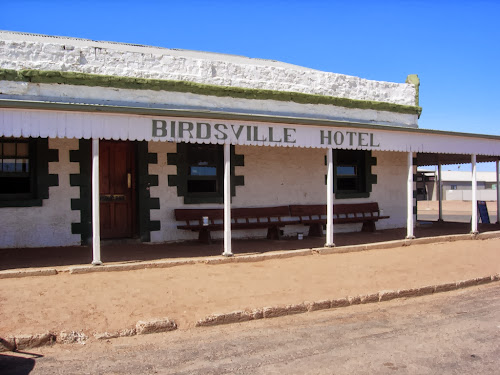The weather prediction from the day before proved to be extremely accurate! The wind continued to increase all day. What started out as a clear day, rapidly became more and more dusty. By the time we arrived in Arkaroola, we could barely see the hills! The wind and dust continued to get worse, so camping now seemed like a very poor option! We gained protection from the elements inside the reception area!


As Arkaroola had been recommended to us as a "must see" place, we reluctantly decided to find a bush camp for the night, rather than retreating to somewhere else. Eating dust with dinner cooked at the camper was not a pleasant thought, so having found our spot for the night, we walked back to eat at the restaurant.
We awoke to clear blue skies, no wind - the perfect day!!
We had booked the previous night to do the Famous Ridge Top Tour, hoping that we hadn't wasted our money! With weather like this it would have to be brilliant!
At this moment, my camera ran out of battery and no electricity with which to charge it! So photos from Peter's camera will be added later. We were priviledged to be driven in four wheel drive vehicles up mountain slopes and over ridges on a road that is inaccessible to the public. The scenery is breathtaking. Sheer drops, red, brown, gold, purple colours of rock and plantlife that clings to life with the occasional rain.
The four wheel driving is extreme! A set of tyres only lasts 3,000klms! The tyres on our vehicle looked battered and worn! We drove over huge boulders, up extremely steep gullies, along hair thin ridges and up to mountain top lookouts with sheer drops on all sides.
The vehicles are cleaned before every trip to ensure no invasive seeds are able to be spread into this pristine place. Regular feral animal clearing is done, no mean feat in this inaccessible place. Often done by helicopter and dropped baits!
It is the greenest in Arkaroola for ten years, so botanists were actively marking and taking measurements of plants thought to be on the edge of extinction! One such plant two years ago, the botanists counted approximately 20, today they had counted over 600!
The plants kill off their extremities in order to survive the conditions out here! So often you think they are dead.
This day in Arkaroola will stand out as the highlight of this tour! Spectacular, scary, awe inspiring! We both loved this wild, fragile, living museum.
Arkaroola is home to one of the very few mobs of Yellow-Footed Wallabies left anywhere, as well as many frog, reptile and flora species. The property, a pastoral lease, is a strange shape, has dispensation not to carry cows and is on average 70klms x 10 klms. It has been a conservation area since the 1960's, before conservation was a name, purchased by the Spriggs family. Sir Douglas Mawson and Sir Mark Oliphant loved the place, for its amazing diverse collection of mineral deposits. It's a living museum for geologists, botonists and zoologists alike.
We were lucky enough to see two Yellow-Footed Wallabies, one at night near our camp, and one on a steep ridge close to our vehicle on the Ridge Top Tour!
















































